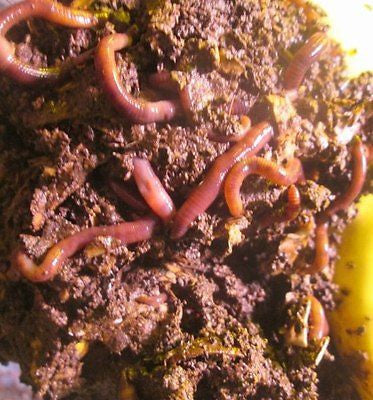Red wigglers: Best methods to keep them
Red wigglers: Best methods to keep them
Blog Article
Red Wigglers: Your Eco-Friendly Solution for a Greener Yard
Red wigglers, or Eisenia fetida, offer a sustainable technique to boosting garden health and wellness through vermicomposting. By integrating red wigglers right into your horticulture techniques, you can properly take care of waste while supporting a dynamic ecological community.
(Raleigh Worm Farms)
What Are Red Wigglers?
Although commonly incorrect for regular earthworms, red wigglers (Eisenia fetida) are an unique varieties recognized for their effectiveness in composting raw material. These worms grow in abundant, natural atmospheres, such as compost heap and vermicomposting systems, where they play a critical duty in breaking down waste. Unlike their even more typical counterparts, red wigglers choose a warmer environment, generally in between 55 ° F and 77 ° F, which optimizes their task and productivity.
Red wigglers are characterized by their reddish-brown coloration and segmented bodies, which can mature to 4 inches in size. They possess a special capability to take in and digest organic products at an outstanding rate, processing up to half their body weight daily. This rapid decay process not just enriches the dirt however also adds to the general health and wellness of the yard ecological community.
In regards to reproduction, red wigglers are respected, efficient in producing cocoons that have multiple eggs. This permits quick population growth, making them an optimal choice for composting ventures. Their flexibility and ravenous appetite for natural waste placement red wigglers as an important ally for environmentally mindful gardeners looking for lasting methods.
Advantages of Utilizing Red Wigglers
Utilizing red wigglers in the yard provides countless advantages that boost both dirt high quality and plant wellness. These earthworms are exceptional decomposers, breaking down organic issue such as kitchen scraps and backyard waste into nutrient-rich spreadings. These spreadings, frequently described as "worm gold," provide essential nutrients that boost dirt fertility, promoting dynamic plant development.
Red wigglers additionally enhance dirt framework. The existence of red wigglers increases microbial task in the soil, developing a growing community that contributes to disease resistance and improved plant wellness.
Another considerable advantage of utilizing red wigglers is their ability to reduce waste. By composting organic products via vermicomposting, garden enthusiasts can draw away waste from land fills while concurrently enriching their dirt. This eco-friendly approach not just supports sustainable methods yet also cultivates a much healthier atmosphere. In recap, integrating red wigglers right into gardening practices yields considerable benefits, making them an important addition to any eco-conscious yard.
(Charlotte Worm Farms)
Just How to Begin Vermicomposting
To begin vermicomposting, it's vital to develop an appropriate atmosphere for red wigglers to prosper, as their success straight affects the efficiency of the composting procedure. Start by picking a container, such as a plastic or wood container, with adequate drainage and air flow. A dimension of roughly 2 square feet is excellent for a household, permitting a manageable worm population.
Next, prepare bed linen material that is moist but not extremely wet. Shredded newspaper, cardboard, and coconut coir continue reading this are excellent choices, offering a comfortable habitat while also offering as a carbon source. Fill the container with 4 to 6 inches of bed linen.
After developing the bedding, introduce your red wigglers. A regular beginning population has to do with 1 extra pound of worms, which can take in roughly half a pound of food scraps daily. It is crucial to add food scraps slowly, concentrating on vegetable peelings, fruit waste, and coffee grounds, while staying clear of meat, milk, and oily foods to stop smells.
Keeping a Healthy And Balanced Worm Container
As soon as your red wigglers are resolved into their new bed linens, maintaining a healthy and balanced worm container comes to be paramount to make sure optimal composting conditions. Ideally, the worm bin ought to be kept damp however not soggy; a humidity degree around 60-70% is optimum.
Temperature control is just as essential. Red wigglers grow in atmospheres between 55 ° F and 77 ° F(13 ° C to 25 ° C) Stay clear of subjecting the container to extreme temperature levels; extreme warmth can eliminate the worms, while extreme cold can reduce their task.
Aeration is important to prevent anaerobic problems, which can bring about undesirable odors and harm the worms. Transform the bed linen delicately every couple of weeks to promote air movement and disperse food evenly.
Feeding your red wigglers is one more vital element. Deal a well balanced diet regimen of cooking area scraps, staying clear of citrus and spicy foods, which can be harmful to their wellness. By routinely checking these variables, you can make sure a successful environment within your worm container.

Tips for Making Use Of Worm Castings
Frequently integrating worm castings into your yard can significantly boost dirt wellness and plant development. To efficiently use worm castings, start by determining the suitable application price, which normally varies from 10-20% of the overall soil quantity. This makes certain optimum nutrient schedule without frustrating your plants.
When applying worm spreadings, mix them into the top few inches of dirt around established plants or incorporate them right into your seed-starting mix for new seed startings. This technique promotes root development and boosts moisture retention. In addition, consider developing a worm tea by steeping worm spreadings in water for 24-48 hours. This nutrient-rich liquid can be used as a foliar spray or soil soak, offering an immediate boost to your plants.

Final Thought
The application of red wigglers in horticulture methods provides a sustainable method to waste administration and soil enrichment. These composting worms not only transform natural waste right into important nutrients but also boost dirt framework and promote a healthy and balanced microbial environment. By adopting vermicomposting methods, garden enthusiasts can efficiently contribute to environmental sustainability while improving plant health and wellness. The integration of red wigglers into horticulture regimens eventually sustains both ecological balance and farming productivity.
Report this page